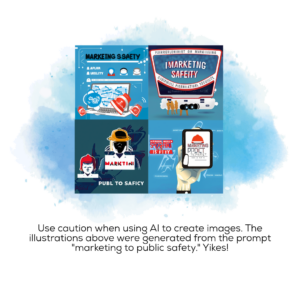
Trust is inherent in the public safety sector.
The general public trusts that first responders can (and will) respond to their emergencies. First responders trust that equipment is ready and in peak working condition every time. As a company with products or services to sell to the public safety market, you, too, need to establish trust to be successful.
Just as in any relationship,trust has to be earned. For the public safety audience, it goes beyond trusting the products and services. They want to trust your company and your brand, too.
The trust that people have in business today is increasing. That means the time is right for your company to connect with your customers in ways that build strong relationships. And the best approach to establish and foster trust is through content marketing. Here’s why.
How Content Marketing Applies to Public Safety
Content marketing delivers thoughtful, credible, solution-based information that addresses problems your audience is facing. The focus is on building relationships — and trust — by prioritizing educational content.
In short, content marketing puts the person before your product and before the sale. While it might seem counterintuitive and run contrary to your previous marketing efforts, content marketing builds relationships that lead to longer customer retention and increased customer loyalty.
First responders want product and service partners committed to their overall success, not those just looking to extract capital and make a sale. Your product needs to work under the most trying. high-stakes conditions imaginable, which meanscontinuous improvement and feedback from the field. Providingengaging and relevant content helps prove your commitment.
Content marketing can take on a variety of formats. The breakdown below covers some of the most common content types, including why and how to use them when marketing to public safety.
Articles and videos deliver informative content.
Articles and videos that live on your company’s website are the foundation of a strong content marketing strategy. This is where you talk less about your product and lean into problem solving to address the needs of your audience.
For example, chainsaws are a public safety product used by wildland firefighters. Companies selling this (or a similar product) and using a content marketing approach could create articles titled “Rookie Mistakes to Avoid with Your Chainsaw” or “3 Essential Tips for Keeping Your Chainsaw Running Smoothly.”
You could also shoot videos that cover basic maintenance practices. This solution-based content establishes a relationship that keeps people coming back to your website and searching for your content.
Infographics make complex information understandable.
Many large-scale purchases in the public safety sector require the consideration of various inputs. A content marketing approach can provide objective guidance to simplify the process.
Infographics — a combination of graphics and text that easily explains complicated information — can help decision makers understand concepts like “How Your Records Management System (RMS) Should Integrate with Your Computer-Aided Dispatch (CAD) System” or “Top Things to Consider Before Purchasing an RMS.”
Webinars establish expertise.
As with any content format, the key to webinars is providing content that’s both relevant and solution-oriented.
Sometimes the content you share won’t be directly related to your product or service — and that’s ok. Providing content on topics slightly outside your offering (but still relevant to the industry) enhances your position as a trusted expert.
For example, a software manufacturer could produce a webinar titled “Understanding NIMS (the National Incident Management System) for Today’s Firefighter.” Or a uniform company could partner with a doctor to talk about melanoma risks and how UV protection in certain fabrics can minimize that risk.
By taking a leadership position on a topic that matters to the industry, your brand canmove into the coveted position of thought leader.
Deploying Content Marketing — Tips to Remember
Your expertise is valuable, so it’s natural to be reluctant about giving away “too much.” When it comes to content marketing, though, a free flow of topics from you to your audience is how you’ll be seen as an expert and a trusted resource.
Content marketing needs to be an ongoing process to be most effective. Think of it as a conversation between your company and your customers (and prospective customers). They have questions or needs. You have answers. You provide those answers through the content you continually share.
As you deploy content marketing within your company, be aware of how your content is positioned, the long-term approach, and ways to optimize your efforts.
1. Think about your product’s features as solutions.
With a traditional marketing approach — one that is more sales-focused — your content likely leads with specific product features. For example, you might start an email with a statement like this: “Our body cam can sustain 180-degree temperatures and never miss a frame.”
But a true content marketing approach considers the pain points your customers are experiencing. It then positions your content in a way that addresses those concerns.
Content marketing requires you to understand the mindset of your customers and empathize with what they are feeling.Firefighters might worry that equipment will malfunction in extreme heat. Given that, you might revise the above statement to say “When temperatures rise, failure isn’t an option.”
This empathetic approach puts the firefighters at the center of the message and speaks directly to their needs. By making this shift, you’re establishing a connection by showing that you understand the problems your target audience faces — and that you have the solution.
2. Know that ROI might take longer with content marketing.
Content marketing focuses on education first and selling second, so the return on your efforts won’t always be immediate.
Reaching your audience with educational content early in the buying cycle — even before they’re ready to make a purchase — opens the door to building a solid foundation of trust and sets the stage for a purchasing decision down the road. Content marketing is a long-term investment that eventually translates into qualified leads, and then into sales.
Because buying cycles in the public safety sector are often longer than other industries, content marketing works especially well. Use your thought leadership content to nurture prospects over time. Then, when they’re ready to talk about a purchase, you will have already earned their trust.
The rapid pace of job transitions in the public safety sector can also mean that the person you’re reaching today may not be in a position with purchasing power. However, they’re still evaluating you based on the content you are sharing.
Thepolice officer who attends your current webinar could eventually be in a decision making or influencing role. If you’ve done the work to provide valuable content they trust, you increase the likelihood that your offering will be top of mind when they are making the decisions.
3. Build a long-term backend solution.
To maximize the value of content marketing, invest in a backend solution that tracks prospects and captures their engagement with your content.
A customer relationship management system (CRM) helps organize what you already know about a person (email, job title, location, etc.) and how they are interacting with your articles, videos, webinars, etc. And it builds over time. As more information is captured, it’s updated on that prospect’s profile. That makes it easier for you to deliver specific pieces of content to the individuals who are most likely to be interested.
A CRM will also help you understand who might be closer to a buying decision. Then you can modify your approach so they’re always receiving the most relevant information.
A backend solution is a long-term investment that doesn’t necessarily need to be built out before beginning your content marketing efforts. Even if you don’t have a sophisticated system in place, content marketing still works. You’ll have less information about who you’re talking to and their level of interaction. But you’re still building trust. You just aren’t able to quantify it — yet.
Commit to Content Marketing — The Results Will Follow
First responders are busy, but they always have time for solutions.
Make their lives simpler and their work easier by serving them aconsistent flow of relevant information. In the end, though, it should all serve to solve a problem or meet a felt need of your audience.
Building relationships and trust with content marketing requires a commitment. When done well, it keeps customers coming back to you for the education, expertise, and, eventually, your offering.
When you’re ready to talk about creating impactful, strategically aligned content to reach your customers and prospects,we’d love to start a conversation.
Related Posts
-
It’s easy in tough economies to want to bypass strategy and go straight to tactics.…
-
We’ve all been there. You work for months on a marketing campaign, only to deploy…
-
No doubt you know all about the Great Resignation. According to the latest Job Openings…








 The RedFlash Group is a GSA Contract Holder under Schedule 541, Advertising and Integrated Marketing Solutions
The RedFlash Group is a GSA Contract Holder under Schedule 541, Advertising and Integrated Marketing Solutions